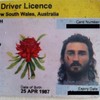All photos by Bryce Noakes.It's a long way from the 40,000 seat stadiums former-National Rugby League (NRL) star Dean Widders once played in, but the nerves are clearly still there. The 37-year-old former Sydney Roosters, Parramatta Eels, and South Sydney Rabbitohs star cuts a solemn figure in the sheds of Erskineville Oval as his team, the Redfern All Blacks, prepare to do battle with arch-rivals, the Coogee Wombats.
Advertisement
"Today's all gonna be about work rate. How hungry are ya to stop that try?" he says.There is no bigger test in park football than the Wombats. The famously Bra Boy-affiliated team from Sydney's south-east have won more premierships than any team in the history of Souths Juniors, a park football competition which has fair claim to being the toughest in the country. For the past two years they have made the grand final only to be beaten both times by a resurgent Redfern All Blacks outfit many are calling the best in the club's history."This is by far statistically and on record the best All Blacks team ever," says Shane Phillips, the All Blacks assistant coach and life member of 40 years.
Former NRL star, Dean Widders, aged 37, is captain of the Redfern All Blacks. Image: Bryce NoakesAlong with back-to-back South Sydney premierships, the All Blacks have also claimed back-to-back Koori Knockout state titles as well as taking out the play off between the top Indigenous NSW and Queensland teams. With a historic double three-peat in the offing, they are on the precipice of park footballing immortality. A remarkable feat considering many of their players were responsible for plunging the community into disarray a few short years ago."We were all the fellas who brought the place down," says Shane. "We used to be the same people who were the ones who caused all the problems, and used to be part of the drug dealing and the drug using, the violence and the drunks," he says.
Advertisement
The success of the All Blacks mirrors that of Redfern and the inner-city generally where there are signs of peace and prosperity following nearly three decades of crime and dysfunction. Once a proud working-class area, topped with a fervent activist streak (the iconic Freedom Rides were spawned here in 1965 and led by local Aboriginal university student, Charlie Perkins), Redfern deteriorated radically throughout the 1980s, 90s, and into the early 2000s as drugs, crime, and violence engulfed the area.
The tensions reached a peak in 2004 following the tragic death of 17-year-old Indigenous teenager, TJ Hickey, who was impaled through the chest by a fence paling after being thrown from his bicycle during a police pursuit (the police were cleared).He died shortly after triggering rioting in the suburb that resulted in more than 40 injured police and the Redfern train station set alight. With relations between Sydney's Indigenous population and law enforcement at an all-time low, local elders—including Shane Phillips—extended an olive branch to police in a bid to calm the streets. Over the coming years, police and the Indigenous community would work together on a number of mentoring programs, including Clean Slate Without Prejudice and Never Going Back, aimed at breaking the cycle of crime and dysfunction.Read the whole story on VICE Sports.
